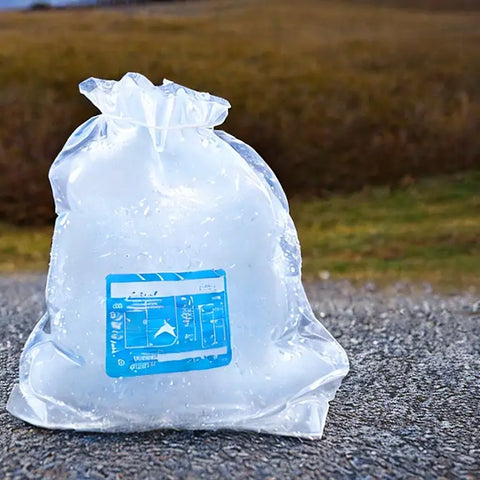What Kind of Good Does Ice Do to Your Face?
An age-old tip for skincare is to apply ice to the region beneath your eyes after getting a full night's rest so that it may help reduce puffiness. Because it also helps brighten your skin before you apply makeup, it is an essential item for those who wish to seem revitalized and radiant.
Because they cause the pores to shut and reduce blood flow, ice cubes are an excellent method for reducing the appearance of greasy skin. They are even capable of calming pimples and reducing redness.
What the ice can do to your appearance:
- Reduce swelling: Cold can help reduce edema by restricting blood vessels and decreasing irritation in the face, which are both factors that contribute to puffiness.
- Soothe acne: Putting cold to acne can help ease irritation and reduce erythema, which can both be symptoms of acne.
- Reduce the appearance of pores: Low temps can briefly restrict pores, giving the appearance that they are smaller than they actually are.
- Brighten complexion: A visage that is lighter and more lively can be achieved by exposing one's skin to cold temps, which have been shown to help improve blood flow and circulation to the skin.
- Reduce under-eye puffiness: Putting ice cubes on your eyes for ten minutes at a time can help reduce the swelling and dark rings that appear under your eyes.
- Relieve headache pain: Putting ice to the brow can help alleviate headache pain by restricting blood vessels and decreasing irritation. This helps relieve headache pain by relieving pressure on the brain.
Deflates the swollen face
When you wake up in the morning, it is not unusual for your face to have a little puffy appearance. This is particularly true if you were dehydrated the previous night or if you ate a large meal. To one's relief, there are a variety of approaches one may take to lessen the appearance of under-eye bags and puffiness.
The use of ice may be an efficient method for reducing puffiness. It does this by narrowing the blood vessels and removing fluid from the area around the eyes, which is what causes puffiness. It not only lessens the appearance of bags under your eyes, but it also lessens the redness and inflammation in your skin.
You might try freezing your face by placing an ice cube on your face or using an ice pack. Both of these options are available to you. This simple and low-cost procedure can assist to reduce the appearance of puffiness and bring out the natural glow in your skin.

Ice has been used for decades by professionals in the beauty industry to enhance the look and texture of skin. To reduce the appearance of facial puffiness, famous makeup artist Lisa Eldridge, for example, often employs ice cubes. In addition to that, she loves to store ice globes in her refrigerator and use them as a massage tool on the areas around her eyes, neck, and decolletage.
A cold water splash on the face is yet another effective method for minimizing the appearance of puffiness. You may take care of this either while you are in the shower or after you have finished washing your face in the morning. It is a natural, inexpensive, and risk-free method that has been utilized by celebrities such as Bella Hadid and Alexandria Ocasio-Cortez to reduce the puffiness that might appear first thing in the morning (per Grazia).
If you have sensitive skin, you shouldn't do an ice facial unless you've experimented with using a very little quantity of ice at first. Then, using gentle circular movements, massage it into your face and around your eyes for the greatest possible benefits.
If you need to apply ice to your skin, be sure to wrap it in a clean towel first and apply it in a very gentle manner. It is essential to refrain from pressing or squeezing your skin too vigorously since doing so might cause it to become irritated and even damaged.
After applying ice to your face, you should follow up the treatment by applying a moisturizer to your skin. By using a moisturizer before your ice facial, you may make it more effective and prevent your skin from becoming dry throughout the treatment.
Brings down the intensity of the redness
A fast and simple method for reducing redness on the skin is to apply ice to the affected area. It does this by narrowing the blood vessels in the skin, which in turn reduces the inflammation and swelling in the skin. Additionally, it may assist in minimizing puffiness and calming irritations.
Ice, on the other hand, does not work for everyone, and it may be problematic for those who already have skin that is sensitive or inflamed. Consult a dermatologist for advice if you are unsure whether or not ice is an appropriate therapy for the kind of skin you have.
Ice should be applied directly to the skin while it is being used, but it should not be left on any portion of the face for more than ten minutes at a time. If left on for an extended period of time, it has the potential to produce frostbite; thus, it is important to take breaks at regular intervals.
You may alternatively use a paper towel or a washcloth to keep the ice cubes in place before applying them to your face. However, you should try to limit the amount of ice that you apply to your whole face at once since doing so might lead to discomfort.
A further piece of advice is to apply ice to your face, but just to the regions of your face that are prone to acne, including your forehead and cheeks. This is due to the fact that scratching the affected region might make the illness worse.
In addition to lowering the look of redness, ice is an excellent method for decreasing the visibility of acne scars. It works more quickly than lotions, washes, and masks to reduce the size of pores and help heal scars.
According to Dr. Hadley King, a board-certified dermatologist in New York City, ice is also fantastic for alleviating the pain and irritation caused by rosacea, eczema, and contact dermatitis. Ice may be applied directly to the affected area for best results.
Icing regions prone to acne is particularly beneficial for treating big cysts, which may be rather unpleasant. According to Craythorne, applying a very little quantity of ice to a pimple might help the blemish to contract and lessen the discomfort that it produces.
When it comes to treating more severe skin disorders like psoriasis, shingles, and rosacea, using ice as part of your at-home skincare regimen may be beneficial. It is possible that adding a few ice cubes to a washcloth is a wonderful starting point, but in order to get rid of your spots altogether, you may require treatments that are more active.
Icing your face with a few drops of a cold beverage is another method that might be effective. According to Dr. Hadley King, it has the ability to help constrict blood vessels, which helps improve puffiness and reduce the look of redness on your face. To maximize the advantages of your ice pack, you may also try adding a few drops of your preferred moisturizer to the pack before you use it.
Calms and soothes irritated skin
If you have a breakout of acne or a pimple, placing an ice cube on the region that is afflicted might help minimize the irritation. In addition to this, it relieves the itching and redness that are caused by the irritated skin. Because of the freezing temperature of the ice, blood flow is restricted, which in turn minimizes swelling as well as discomfort.
The acne or pimple will get drier as a result of the ice, which will result in a less noticeable look. Rashes, such as those caused by allergic reactions or bug bites, are another condition that may be remedied with its use.
Because repeated exposure to ice may be harmful to the skin, it is not advised that you use it more than once each day. If you have sensitive skin, instead of using a hot compress, you should try using a towel or a cold compress.
Ice should be applied to the face using gentle circular strokes for the greatest possible outcomes. Begin at the top of your head with your forehead, then move your way down to your chin. Pay special attention to the region beneath your eyes as well as any other parts of your face that feel swollen. The full procedure of applying ice shouldn't take more than twenty minutes to complete.
You may also replace regular ice cubes with frozen aloe vera gel, rose hydrosol, green tea, or cucumber water for additional soothing effects. This can be done by substituting the standard ice cubes. Because of their antimicrobial, antiviral, and antioxidant characteristics, these components may hasten the recovery process for sunburns and acne.
In addition to this, the use of ice helps lessen the appearance of wrinkles and fine lines. Your skin might end up appearing more radiant and youthful as a result of this.
Because it brings down inflammation and reduces the appearance of redness, a good ice facial may even help prevent acne from appearing in the first place. This is particularly helpful for those who have melanated skin since continuous irritation and inflammation may make it more difficult to regulate the disease.
Ice may also be used with other natural skincare products that contain vitamin C, such as rosehip oil, for an alternative method of treatment. Acne and eczema patients who undergo this therapy may have a reduction in the accompanying inflammation and irritation.
The procedure may be used on the whole face, but the areas of the face that will see the most improvement are the forehead and the cheeks. This may be done on a twice-weekly basis if desired.
You may also boost the absorption capacity of other skincare products by rubbing ice over your skin before applying them. This can be done either before or after using the goods. Because of this, your skin may be able to absorb more of the chemicals, which will help it continue to appear healthy and vibrant.
Brings down the swelling
Ice, in general, is beneficial for reducing swelling because it causes blood vessels to contract, which in turn stops blood from going to the skin. In addition to this, it causes the production of hormones, which, depending on the nature of the inflammatory skin disease being treated, may be useful.
However, before to using it on your face, you should always get the advice of a dermatologist first. They are able to assess your condition and provide guidance on the quantity and frequency of ice applications based on their findings.
Facial swelling may be brought on by a variety of different things, such as an accident, being dehydrated, or being allergic to something. It's also possible that this is a symptom of an infectious condition. If it causes you to endure extreme discomfort or makes it difficult for you to breathe, then you should seek emergency medical attention as soon as you possibly can.
Applying ice directly to your face may also help minimize the size of blemishes and other skin imperfections like acne. It is sufficient to place a piece of ice directly on the imperfection and keep it there for a few moments, until the area becomes numb.
You may try applying crushed ice to the areas of your face where you have acne, such as your cheeks, forehead, or chin, to enhance the look of your blemishes and prevent new outbreaks. This will not only help lessen the redness of your pimples, but it will also help minimize the inflammation caused by them.
In addition, you may find that a face massage is helpful in both relaxing you and stimulating your lymphatic system. The tension in your face will be relieved, and any puffiness will be reduced, all of which will contribute to your more youthful appearance.
This is of utmost significance if you suffer from a hormonal imbalance that causes your face to seem puffy. Maintaining a healthy hormonal balance and minimizing puffiness are both benefits of doing enough physical activity.
It is also possible to lessen the appearance of edema if you take steps to ensure that you are receiving adequate sleep and drinking enough water. This will guarantee that your body gets the energy it needs to recover from injuries and heal any harm that has been done to it.
In addition, maintaining a healthy diet might assist you in minimizing edema in your face. Your body's ability to fight against infections and your thyroid hormone levels may both be maintained by taking this supplement.
Adopting good oral hygiene habits is another method that may be used to lessen the appearance of facial edema. Maintaining healthy gums and avoiding facial swelling may be accomplished by practicing good oral hygiene habits such as flossing, brushing twice daily, and gargling with mouthwash.


















































Leave a comment